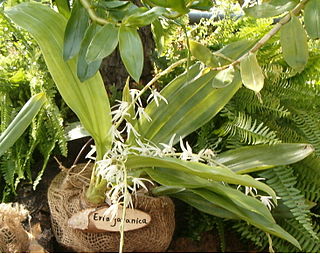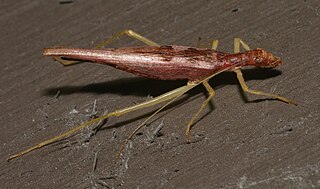
Moonmilk is a white, creamy substance found inside limestone caves. It is a precipitate from limestone comprising aggregates of fine crystals of varying composition usually made of carbonates such as calcite, aragonite, hydromagnesite, and/or monohydrocalcite.

Adalia bipunctata, commonly known as the two-spot ladybird, two-spotted ladybug or two-spotted lady beetle, is a carnivorous beetle of the family Coccinellidae that is found throughout the holarctic region. It is very common in western and central Europe. It is also native to North America but it has heavily declined in many states and provinces. It is commonly introduced and imported as a biological control agent.

Plethodontohyla bipunctata is a species of frog in the family Microhylidae. It is endemic to Madagascar. Its natural habitats are subtropical or tropical moist lowland forests and heavily degraded former forest. It is threatened by habitat loss.

Adalia is a genus of ladybugs in the family Coccinellidae. It contains only two species, A. bipunctata and A. decempunctata.

Eria is a large genus of orchids with more than 500 species distributed in China, the Himalayas, the Indian Subcontinent, Southeast Asia, New Guinea, Polynesia, Melanesia and Micronesia.
Ulidia bipunctata is a species of ulidiid or picture-winged fly in the genus Ulidia of the family Ulidiidae.

Haptogenys bipunctata is a species of combtooth blenny found in the western Pacific and Indian Oceans. It is the only known member of its genus.

Steatoda bipunctata is a species of cob-web spider, of the genus Steatoda, in the family Theridiidae.

Diplacodes bipunctata is a species of dragonfly in the family Libellulidae, known as the wandering percher or red percher dragonfly.
Cyclophora bipunctata is a moth in the family Geometridae. It is found in Peru.

Sybra is a genus of beetles in the family Cerambycidae, containing the following species:

Sybra ordinata is a species of beetle in the family Cerambycidae. It was described by Bates in 1873.

Macromonasbipunctata is a Gram-negative, colorless, and heterotrophic sulfur bacterium of the genus Macromonas. It is commonly found in sewage aeration tanks and caves where moonmilk has formed. In the 1920s, researcher Gicklhorn first discovered this organism under the name Pseudomonasbipunctata. After further study and culturing by Utermöhl and Koppe, in 1923, it was later renamed Macromonasbipunctata. This organism is thought to be non-pathogenic species. In fact, the moonmilk produced was referenced as a remedy for infections in the Middle Ages.
Menesia bipunctata is a species of beetle in the family Cerambycidae. It was described by Zoubkov in 1829, originally under the genus Saperda. It has a wide distribution in Europe and Asia. It measures between 6 to 9 mm. It feeds on Juglans regia and Frangula alnus.
Nupserha bipunctata is a species of beetle in the family Cerambycidae. It was described by Per Olof Christopher Aurivillius in 1914.

Neoxabea bipunctata, the two-spotted tree cricket, is a species of tree cricket in the family Gryllidae. It is found in North America.

Nitidula bipunctata, the two-spotted sap beetle, is a species of sap-feeding beetle in the family Nitidulidae. It is found in Europe & Northern Asia and North America.
Clitemnestra bipunctata is a species of sand wasp in the family Crabronidae. It is found in Central America and North America.
Loricula bipunctata is a species of minute bladder bug in the family Microphysidae. It is found in Europe & Northern Asia and North America.
Seira bipunctata is a species of slender springtail in the family Entomobryidae.













